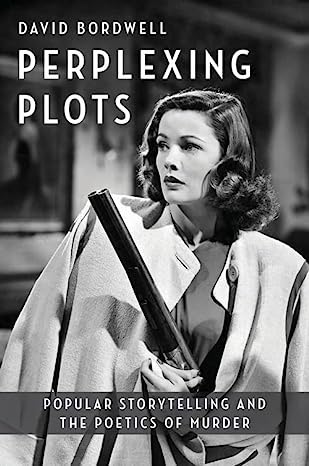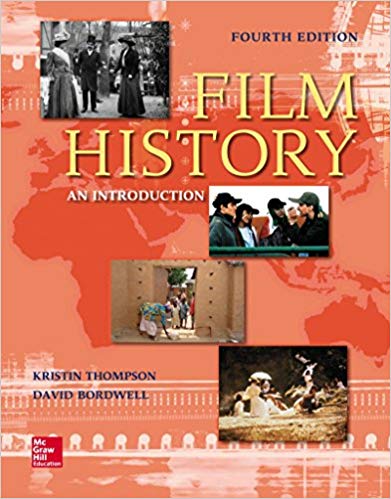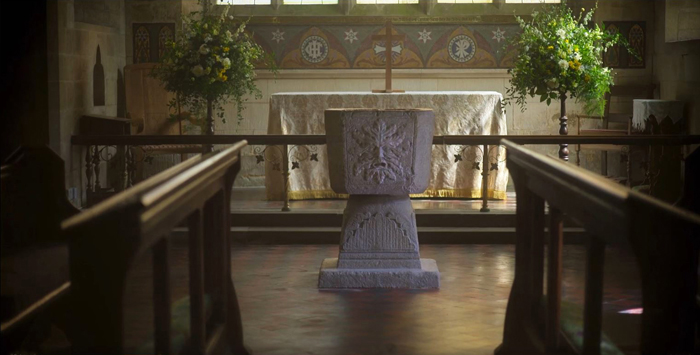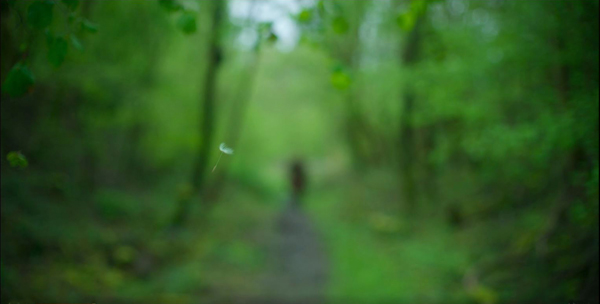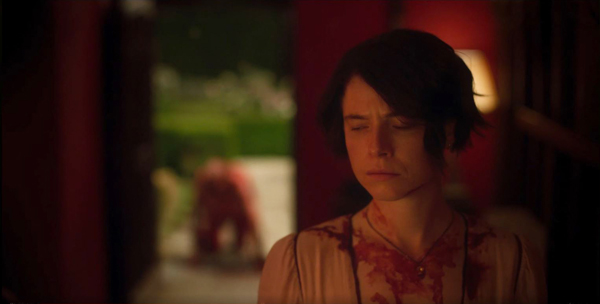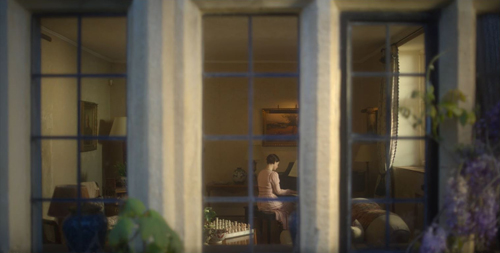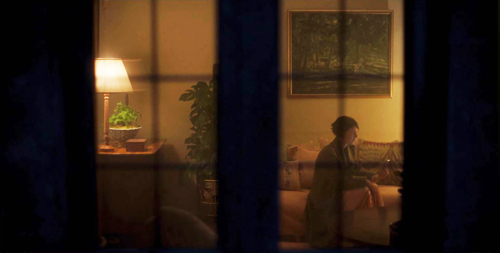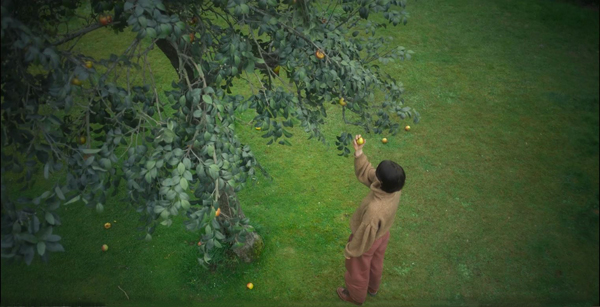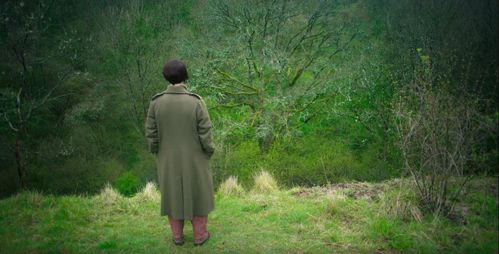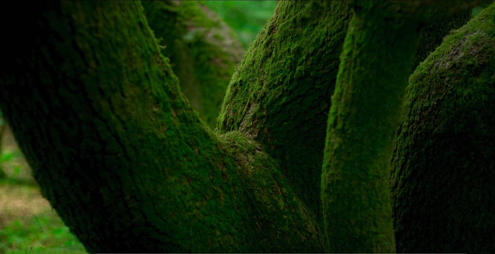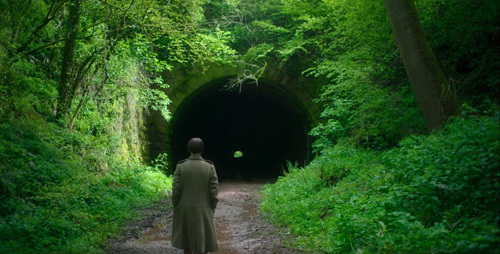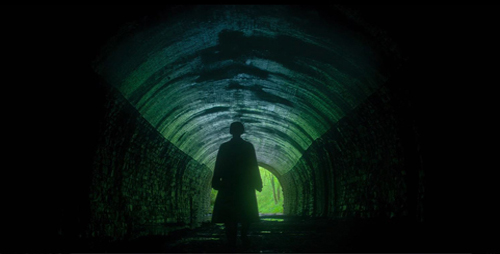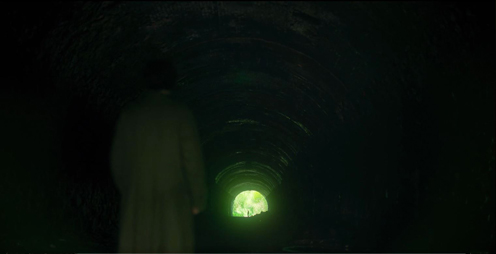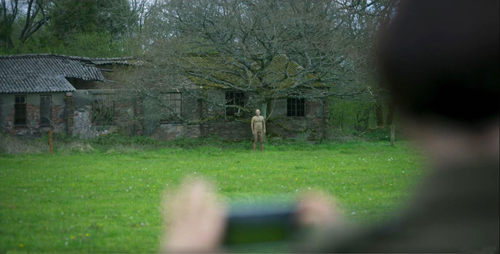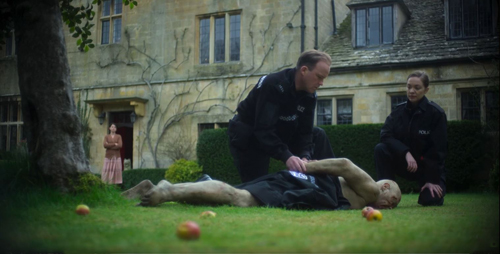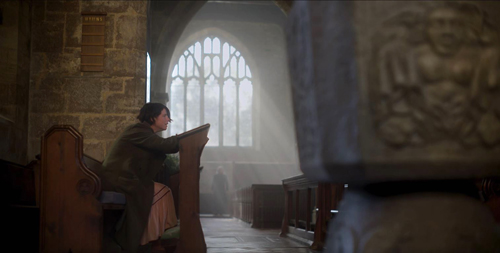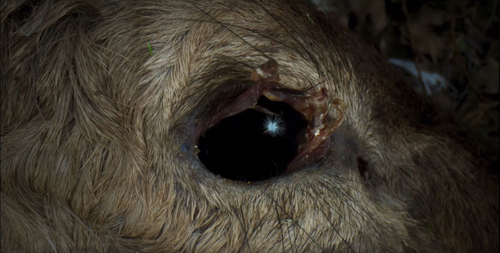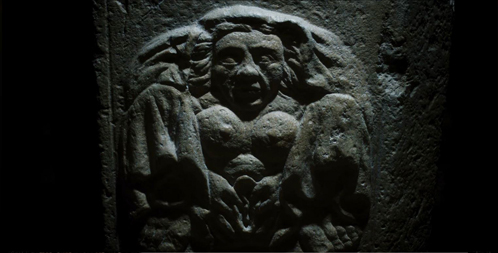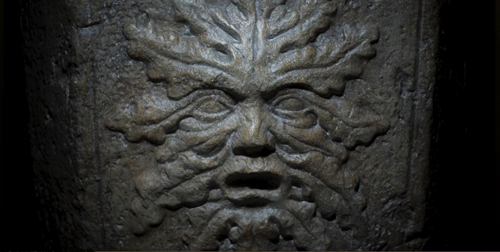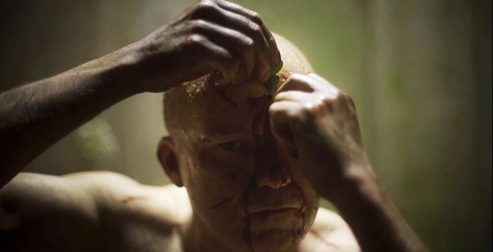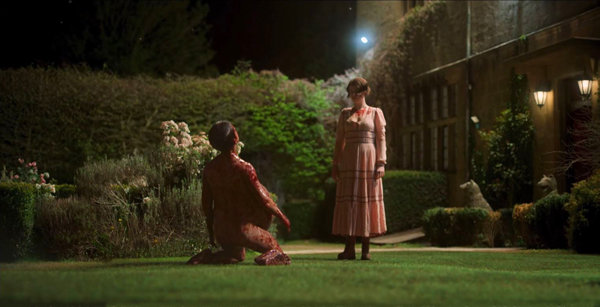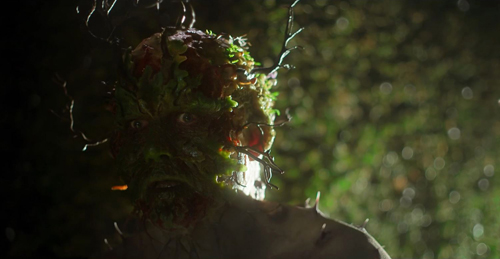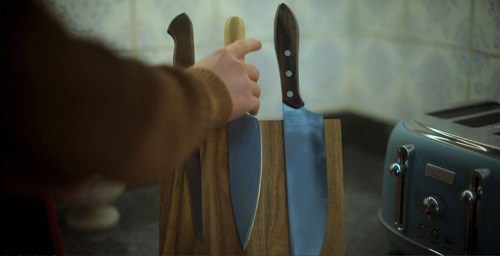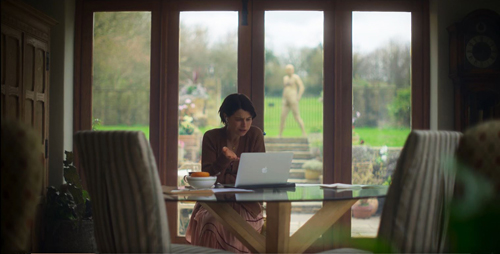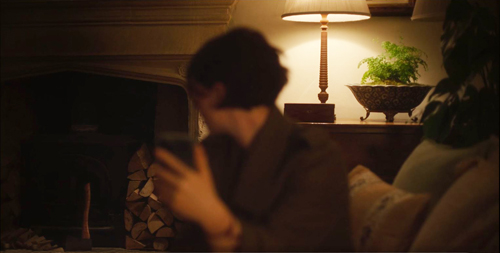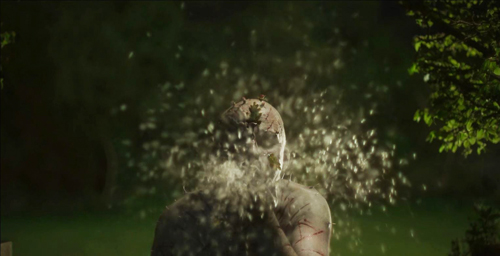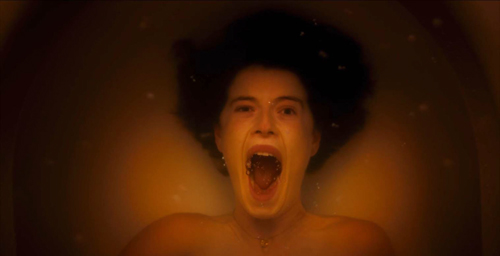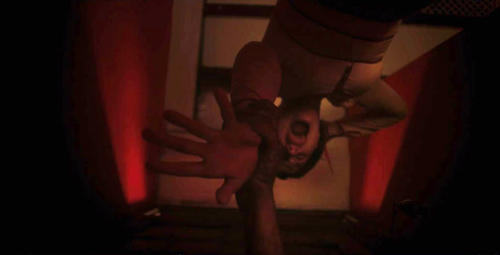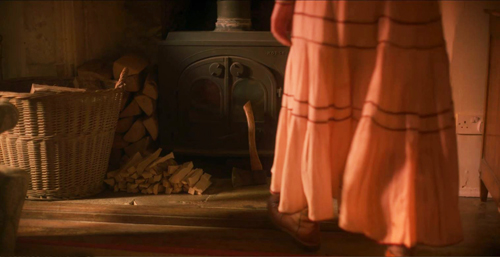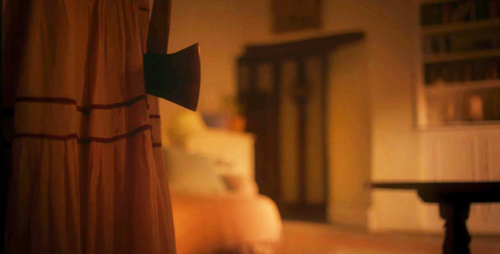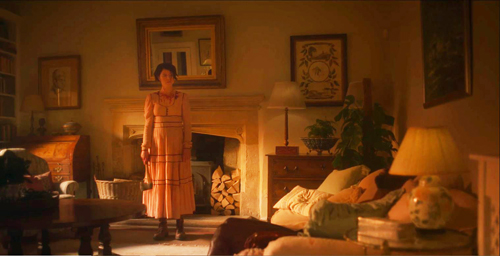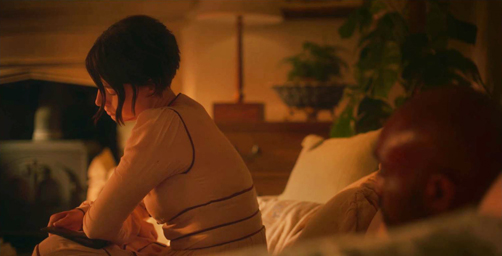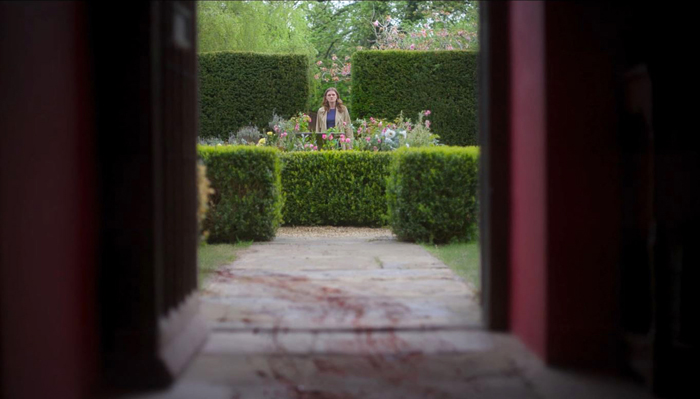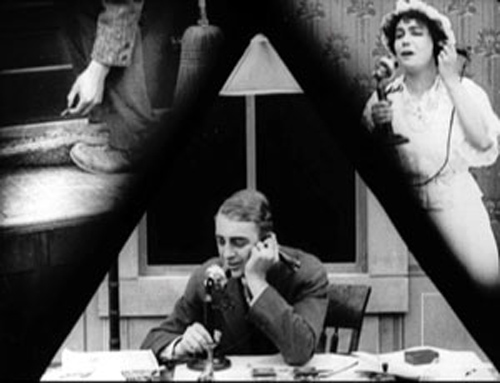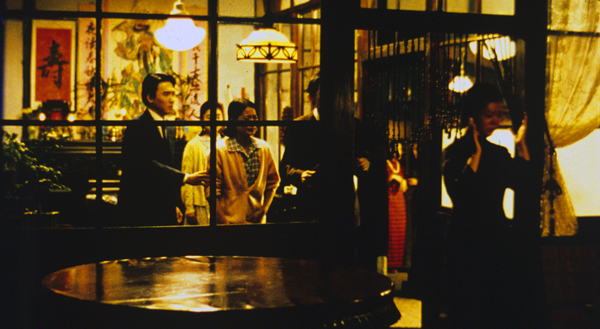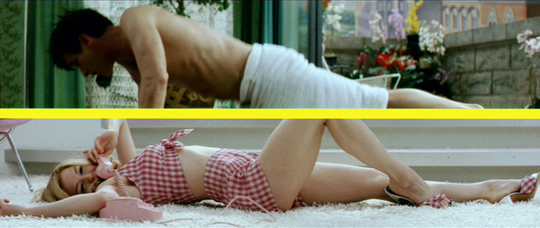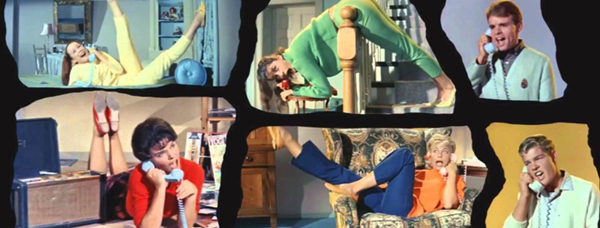Archive for July 2022
Figuring out MEN
Men (2022).
In an earlier entry I considered films identified as “prestige horror” and traced how the idea developed among critics and journalists in the mid-2010s. That entry was written just after I saw The Northman, Robert Eggers’ next film after The Lighthouse; it was also the first of four films being released this year and early next year, each directed by one of the four directors generally identified with the trend.
Now Alex Garland’s Men has quietly come and gone, at least in theaters. I write this a few days after distributor A24 showed a double feature of Men and Ex Machina, available for one day only, on their occasional “Screening Room” streaming series, which was launched in response to the pandemic with Minari on February 12, 2021.
Seeing Men a second time made it possible for me to take notes and get a better grasp on the complex and oblique narrative of the film. That narrative has apparently perplexed most critics and audiences, resulting in considerable annoyance. I could follow it reasonably well, and I understood what happened at the end on first viewing–a particularly annoying section for the perplexed. This second viewing confirmed that I had been right about the ending, though I find that it was set up even more carefully than I had noticed.
At first I thought I should wait until Men arrived in a more conventional continuous streaming fashion. In preparing this entry, though, I learned that the DVD and Blu-ray release date has been announced as August 9. No subscription streaming date has been announced, although one can now buy the film from several providers for $19.99. Kudos to A24 for committing (so far) to bringing out all its films on physical media as well as streaming.
So my timing may not be too premature, but I realize that many will not have had a chance to see the film yet. I should emphasize that there are major spoilers ahead. I am going to reveal what happens at the end in some detail, as well as analyzing the imagery in the film and making a stab at what it’s all about.
Challenging films
Before I launch in, I would like to say something about highly unconventional films that defy our expectations. Increasingly I read adverse reviews of such films. They seem to have upset the writer by not turning out to be what he or she expected upon entering the theater. I first noticed this response in watching László Nemes’s Sunset (2018) for the first time. Within ten minutes I was baffled but excited at the prospect of what was obviously a masterpiece. Despite my puzzlement, I think I got the gist of it and certainly sensed what Nemes was doing stylistically. I was startled to read the professional reviewers’ mostly negative notices, seemingly based on annoyance at being puzzled. Having the chance to see Sunset a second time on a screener, I understood it better and wrote up an analysis of it.
I’ve seen this sort of thing happen occasionally since, notably with Leos Carax’s Annette last year. I don’t think it’s Carax’s best film or as challenging as Sunset or even Men, but it deserved better than it got from a lot of reviewers.
I would assume that the duty of anyone writing about a film for publication, particularly one who gets paid to do so, is not to judge a film by whether it conforms to the expectations he or she brought into theater. If a film is challenging in the way these examples are, the obvious strategy is to try and figure out what the film is trying to do. How and why is it puzzling or unconventional? I remember that one professional critic who shall remain nameless wrote that she wanted to like Annette but wasn’t able to. I would say that the critic’s duty is not to like or dislike a film. That’s the realm of buffs reviewing on Facebook or Google or wherever. The critic’s duty is to understand it, to figure it out, or at least to make the attempt. I realize that such films really need to be watched a second time to get a better grasp on their strangeness, but even on a first viewing one can usually discern that a second viewing is worthwhile, and why.
Of course, trying to figure a film out may lead one to conclude that it really is bad. Maybe it’s not experimenting in original ways or it’s using flashy style gratuitously. But if the viewer does figure it out and it’s good, even a masterpiece, he or she has discovered something–a process that I find rewarding and pleasurable, whether or not I ultimately don’t much like the film.
I’m not claiming that Men is an undying masterpiece, though I do admire it more than many do. The point is that a significant number of adverse reviews reflect the same sort of unwillingness to engage with the film’s unconventionality.
This unwillingness makes me wonder what happened to the sort of openness to originality and even occasional experimentation that existed from the late 1940s, for several decades, when such films as Voyage to Italy, Hiroshima mon amour, 8 1/2, Pickpocket, Persona, Death by Hanging, and other unconventional films of the golden age of art houses. Would such challenging films be hailed and become long-treasured classics? I hope so, but …
The final and only girl
Again, I’m not going to point to particular reviewers, but many have gone for the obvious and describe the film solely in terms of the misogynistic males. Are all men misogynistic?
I do think that the title was a big mistake, inevitably egging critics on to batten onto the toxic masculinity displayed by all the male characters as the the obvious, straightforward point of the film. In that case it would be pretty simple and overly obvious. I think the form and style of the film make it more complex than that. I suspect that critics thought of the film as a sort of social commentary first and a horror film second. This may be one of the disadvantages of prestige horror. To some extent the films can be seen as art cinema rather than regular horror pictures, and therefore ripe for interpretation rather than analysis as horror films. In fact they seem to be a combination of art and genre types.
But however arty, Men is a horror film. The villains of horror and especially slasher films tend to be grotesque, often wearing masks and wielding chainsaws and the like. It’s a well-established convention. From at least Psycho on, these villains are seen as madmen, deviants, not representatives of the traits of an entire gender. They are basically monsters, some endowed with supernatural traits, as are the male characters in Men.
In struggling to figure what Garland was up to in Men, about halfway through it dawned on me that he had neatly reversed the “final girl” plot. This common structure in the slasher sub-genre of horror films was formulated by Carol Clover in her Men, Women, and Chainsaws: Gender in the Modern Horror Film (1992). Her insights have become common currency in the field, with “final girl” having its own Wikipedia entry. A crazed killer picks off a group of victims, often a bunch of male and female teenagers, in a shooting-gallery narrative. Clover points out that typically only one, usually a girl or woman, manages to survive and kill the group’s nemesis.
Men does exactly the opposite. There is a set of male villains, mostly characterized as simply obnoxious at first and becoming increasingly dangerous until they are revealed as murderous, supernatural monsters. (Samuel’s incongruous blonde female mask may be a reference to those worn by such villains.) There is no group of victims, no final girl, just the only girl, who manages to wipe them all out.
Harper is, to be sure, initially seen as a victim, pursued by the Naked Man early on and ultimately by Geoffrey, who tries to run her down in her own car before crashing it. (None of the village men apart from Geoffrey and the little boy, Samuel, is given a name. “Naked Man” seems to be what people use for him.) She is terrified in many scenes and forced to retreat to her rented house, which proves inadequate to keep these guys out. Occasional shots of her in the house are seen through the large windows, as if from a lurking villain’s point of view–a common convention of slasher films.
At one point she is nearly defeated, declaring to her friend Riley that she will give up her vacation and leave, though she seems more angry than frightened. Riley urges her to stay, however, and Harper fights back–ultimately successfully.
I’m not sure Garland is the only filmmaker to create such a reversal of this widespread convention. David and I happened to watch Edgar Wright’s Last Night in Soho (2021) recently, and one might say that something vaguely similar is going on. Again one woman wreaks her revenge on a series of monstrous males. There may be other such films, but I think Men is a particularly original and clever example.
They don’t call it Mother Nature for nothing
I obviously haven’t been able to read all the reviews, professional and amateur, of Men. I’ve read quite few, though, and I have yet to find one that deals with the motif of nature in the film, though some refer to the Green Man motif. The gender politics are obvious, however one interprets them, but they are bound up with the treatment of the natural world in the film. It’s a combination that both make the film more complex and give some depth and originality to the treatment of the dreadful men.
The early parts of the film stress the beauty of the English countryside, a major factor in Harper’s search for a place to recover from the grief and guilt she feels in the wake of her husband’s suicide. She rents a luxurious country house for two weeks. Upon arriving, she plucks and eats an apple from a tree in the front yard. Geoffrey, the landlord, takes the occasion to pretend that there is a rule against “stealing” the apples, and after Harper confusedly apologizes, he reveals it was a joke–albeit a mildly cruel one that suggests he isn’t entirely the jovial if awkward fellow he seems at first.
In the morning she seems not to know what to do in the house, and in a long sequence she takes a walk that gradually undermines the sense of the bucolic, restful countryside.
Harper enters a forest, the beauty of which is emphasized by the lush cinematography. The exteriors in this part of the film are dominated by bright spring greens and occasional flowers.
At one point she pauses, staring down into a valley at a tree. There seems to be nothing remarkable about it, apart from perhaps the fact that some of its branches are entirely green because of a thick coating of moss–something that appears on other trees as well. Her pause should cue us to pay attention to the forest as a possibly significant motif. This imagery of moss-covered trees appears in a cutaway outside the house in a later scene.
As Harper walks along a path, a gentle rain begins, and she stands delightedly listening to distant thunder and the patter of the rain. The moment is a sample of how this contact with nature delights this city dweller and could have a calming effect on her. The freedom to commune with nature in safety, however, is soon to be taken from her.
Harper approaches a tunnel that is the setting for the most widely praised scene of the film, one that will change the direction of the action radically. Again it takes place amid bright green foliage, which creates a sharp contrast with the darkness of the tunnel. As she calls out and moves into the tunnels, singing to hear the repeated echoes (which she does not notice do not always match her voice exactly), a cut takes us deep into the tunnel, with the darkness swallowing up the green forest, almost like an iris-out.
Another reverse shows an even smaller spot of green as Harper sees the silhouette of a man at the other stand up and run toward her. As she flees through the forest, there is a mysterious shot of the pursuing man, unidentifiable in the unfocused depth, while a single fluffy white seed drifts past in focus in the foreground (see image at the top of “Challenging Films.”) This sort of seed will itself become a minor, and mysterious, motif.
Hurrying out of the forest, Harper pauses to photograph a deserted house and spots a naked man. He apparently is not the man who pursued her; from the glimpses we get of him, he appears to be clothed.
Harper returns home, and this scene puts an end to her hopes to take walks in the countryside, something she does not do again. The bright greens become far less prominent, and later scenes tend to take place at night.
The next morning the Naked Man walks around outside the house and tries to break in. The Constable and his partner (the only local woman in the film) arrest him. The scene makes the intruder both threatening and pathetic, with his grubby skin and open sores.
The Naked Man will become linked to a motif introduced in the next scene. Harper goes to visit the nearby village, planning to see the church and try the local pub. In the church there is a carving on the front of a marble font (top image): the Green Man, an ancient, widespread medieval pagan figure associated with rebirth. It faces Harper as she walks forward along the central aisle.
We then see what she does not. On the opposite side of the font, invisible from the pews, is a female figure, a Sheela na gig, a sort of traditional pagan counterpart to the Green Man. She is invariably a seated women with spread legs pulling open her exaggeratedly large vagina. Despite both being of pagan origin, these two mythical characters have been part of the decoration of many churches in Ireland, the United Kingdom, and Europe, and quite a few still survive.
The Sheela na gig figure is framed in the foreground as Harper sits weeping at the memory of her husband’s suicide and the local Vicar appears dimly in the background.
There follows a scene in which the Vicar pretends to comfort Harper, initially seeming sympathetic but then suggesting that her refusal to forgive her husband when he struck her drove him suicide. She leaves indignantly, while he sits stroking the bench where she had been sitting.
There follows an enigmatic scene in the forest with none of the characters present. In extreme close-up, a fuzzy seed drifts into the hollow eye-socket of a decaying deer. A cut that seems to follow it into darkness leads to a shot of the Sheela na gig relief. In the light of what happens later, we should keep in mind that this relief is on the surface facing away from the congregation and into the space occupied by the Vicar for all the time he has worked in this church.
The next shot shows the Green Man face, made, as such figures are, of foliage. A brief series of shots of the Naked Man in a strange sort of den or cell, culminating in a close-up in which he peels some skin from his forehead and sticks a leave into his raw flesh. The camera then rises slowly from the carcass of the deer.
This interlude has not been any character’s subjective vision or dream. It is part of the motivic commentary on the action of the film and will come to make sense later on.
Immediately after this scene comes Harper’s visit to the pub where she learns from the Constable that the Naked Man has been released. At that point she calls Riley, saying she is leaving. But her friend urges her to stay and says she will drive to join her in defying the aggressive village men (and boy).
That ending
The ending seems to baffle most viewers.
All of the male characters show up at the house. Most threatening is the Vicar, who corners Harper in the large bathroom and declares his lust for her. He describes her in lewd terms that are based on the Sheela na gig figure–open legs, cave-like vagina, and an open mouth.
After this series of threats and attacks by the main male characters, Harper tries to flee in her car. She fails when she hits Geoffrey, who steals the car and tries to run her down. She takes refuge, if one can put it that way, in the garden in front of the house as Geoffrey crashes her car into wall outside, cutting off that method of escape.
At that point the Naked Man, now fully transformed into a semblance of the Green Man, enters. Now finally covered with leaves and twigs, he resembles the figure carved in the church. He is not a genuine Green Man, however, not being made of vegetation but having pressed all these leaves and twigs into his body.
Launching an impressively intense foray into body horror, the Naked Man lies down and gives birth to Samuel, who kneels before Harper, his belly swelling (above) until he gives birth to the Vicar, who crawls feebly into the hallway as Harper turns away in contempt (frame atop the “Only Girl” section). He then gives birth to Geoffrey, who gives birth (or vomits?) Harper’s husband James through his mouth.
Unlike the others, James is not covered in blood and does not continue the male-birthing chain. He sits down and blames Harper for the injuries incurred during his suicide, which he still bears despite his “rebirth.” Nevertheless, he demands her love. She turns away, wearily sighing, “Yeah.” Cut to a large red title against black: MEN.
An epilogue follows immediately, with Riley arriving to find the door standing open and signs of bloody objects being dragged (see bottom). Ironically, she is revealed as pregnant, and the flowers return as she approaches the house (see bottom). She spots Harper sitting calmly on a stone stairway in the garden and joins her. The two women reunite happily.
That’s quite an ellipsis. What happened “during” the scene elided by the MEN title? It seemed obvious to me on first viewing that Harper killed James and any of the others who might still be living, though my impression is that each died after giving birth. What happened to the corpses? No idea. Maybe they magically disappeared, as they had magically arrived. After all, earlier we had seen two characters, the Constable and Geoffrey, instantly disappear into thin air. If that happened, why the bloodstains remain is a mystery. Still, one thing I was sure of: James and the others are all dead and gone.
How do we know this? The signals are clear, but one needs to watch carefully. Chekhov famously wrote several times in different variants that “If in the first act you have hung a pistol on the wall, then in the following one it should be fired. Otherwise don’t put it there.” The principal is known as “Chekhov’s gun.”
Garland follows this guideline and prepares for the final elided murder.
First, during the morning scene when Harper is working remotely and fails at first to notice the Naked Man outside, she goes to the kitchen and a close-up emphasizes her hand plucking one of three knives from a holder to cut an orange. Immediately afterward we see the Naked Man again as she resumes work, the orange beside her–reminding us that she does have a means of defense. He tries to come in, but she successfully locks the door and simply calls the police.
After Harper learns at the pub that the police have just given the Naked Man a bath and clothes and released him, she calls her friend Riley to report the various nasty encounters with the Vicar, Samuel, and the Constable. Riley offers to join her at the vacation house, adding, “If that fucking weirdo comes back, I’m gonna take that axe and chop his dick off, and he can fucking choke on it.”
Harper asks, “What axe?” and Riley says it’s behind her. As indeed it is. (The fireplace beside which it sits has been seen and mentioned already. Not that it’s ever lit, but it’s where the axe is.)
Now we’ve had two potentially deadly blades called to our attention. Knowing Chekhov’s rule, from this point on I was assuming Harper would use that axe in a climactic fight.
But since we don’t actually see the axe used with deadly force, Garland needs to show that she would kill someone with it if necessary. Hence the return of the knife.
At about sixty minutes in, the attacks on Harper in her house begin. The mysterious Constable who had released the Naked Man appears on the lawn and then vanishes instantly. Immediately one of the thugs from the pub tries to get into the house. Harper grabs the same knife and hides in the kitchen, where Samuel enters. She refuses to use it on a child, and when Geoffrey appears, she still trusts him. He pretends to search the garden before suddenly disappearing, as the Constable had done.
At that point the Naked Man returns and blows a handful of fluffy seeds into Harper’s face, seen from her POV. He has visibly made some progress toward turning himself into a Green Man.
The seeds seem to send Harper into a trance. She falls backward in slow motion and has a vision of herself possibly drowning. A quick montage of earlier scenes follows, but she recovers and manages again to slam and lock the door to keep him out.
At this point the Grand Guignol aspects of the action ramp up as the Naked Man sticks his arm through the mail slot and grabs Harper’s wrist. In a dramatic shot from below, she stabs his arm.
As Harper watches the Green Man withdraw his arm through the slot, its edges pull the knife through his forearm and hand, splitting them in two down the middle. (This horrendous wound is transferred to the other men who have harassed or endangered Harper.) Shortly thereafter, when the Vicar arrives (with the split arm), he accuses her of trying to control him with her carnal powers and nearly rapes her. She uses the knife again, this time to kill him.
By this point we should be thoroughly convinced that she would be equally capable of wielding an axe. Indeed, part of the suspense during the “rebirth” scene is when she will finally go and pick it up. She does so as Geoffrey “gives birth” to James. Garland emphasizes it with a low framing of it and the door through which James enters.
James collapses on the sofa, and Harper crosses to sit beside him. She doesn’t put down the axe, as we might expect her to do if she is considering admitting that she still loves him. It should be noted that he still has his broken leg (which is also shared with all the other males in the rebirth scene) and his other wounds from his suicide. He is not her real husband James but some simulacrum of a human, like the bloody monsters we have seen emerge during the rebirths. That has to be understood if we are to accept what is implied to happen next. In the last shot of the scene, Harper does not tell James she loves him or that she is sorry for having contributed to his suicide. She just sits fingering the blade of the axe. Cut to the “Men” title.
I think there’s no doubt that, unseen by us, that axe gets used. Chekhov was right. Clearly Garland, although he made us cheer on Harper as a strong woman, doesn’t want us to see her chopping up her husband, dead though he may actually be already, and we don’t want that either.
How hard is this to grasp when watching the film? Hard, maybe, but not impossible. Christen Warrington-Broxton posted a piece on Google’s page for amateur film reviews. She offers a cogent analysis of the film, including a response to those who claim that the final scene of the climax does not resolve the action. She points out that “our heroine is clearly calculating how she will dismantle that mess with the axe.” During the rebirth segment of the scene, “the modern woman walks away from the inevitable and pathetic rebirth of toxic masculinity that comes for her: the ex. She goes to wait to prepare herself emotionally, and physically with the weapon her female friend pointed out to her. She must destroy this presence in her life.” (Ms Warrington-Broxton also identifies the Sheela na gig, a figure I had not been aware of.)
Oddly enough, though, the Vanity Fair review presents a pretty cogent summary of the action and does not even speculate about what happened between James and Harper after that cut to the title. No mention of the axe or the possibility that violence occurred. Particularly odd for a piece entitled “Men: Let’s Unpack that Disturbing, Disgusting Ending.”
Finally, why bring in the Green Man and Sheela na gig imagery? What is the point of having all the males apart from James played by the same actor? Why make all the village males bear the same horrific wounds, even though only each wound was inflicted on only one man? And why do those wounds echo those of James as he hands impaled on an iron fence and with a grotesquely broken leg after his suicide jump? (Geoffrey suffers a similar leg wound when hit by Harper’s car.)
To be brief, Garland reverses the usual associations of the two mythical figures, who are generally regarded as positive forces–the Green Man as a emblem of rebirth and the Sheela na gig as a protector against evil and, not surprisingly, a fecundity symbol. The film presents them as grotesque and threatening or lewd. The males in the film are linked to them as if to the archaic beliefs, especially about women, of a long-gone time.
The similarities among the male villagers might simply be seen as a blanket condemnation of all men simply as misogynists. Since this is a horror film, however, the point is to make them all monstrous and grotesque in a similar way, sharing the atavistic instinct that drives their behavior toward Harper. The casting of Rory Kinnear as all of these men emphasizes this shared instinct. It also sets them apart from James, who is a classic domineering, guilt-tripping husband but not a literal monster until he joins in the chain of rebirth at the end.
Prestige horror going forward
The two films released since I wrote my first piece have not done well. As of July 18, Box Office Mojo listed Men as having earned $10,304,884, about three-quarters of which came from the North American market. The budget isn’t known, but it’s hard to imagine one so low that Men could come close to making a profit, even given that various forms of home-video are yet to come.
The Northman has been streaming for some time now, but again, with a budget estimated at $80-90 million, it does not look like a hit.
One thing is interesting to note, though. I pointed out in my first entry that the “prestige horror” films by the four directors discussed have all scored higher on Rotten Tomatoes among critics than among audiences. By contrast, more conventional horror films nearly always had higher marks from audiences than from critics. Men did worse on Rotten Tomatoes than any of the earlier prestige films listed in the previous entry had, with a 69% positive critical response and a 40% audience one. It’s quite a come-down, but the critics’ score fits the pattern by remaining higher. Last Night in Soho upheld my claim that more conventional horror films did better with audiences; it scored 76% with critics and 90% with viewers.
Whatever the outcome of Men‘s streaming life for A24’s bottom line, Garland apparently wants to quit directing and go back to writing. He has been saying this in interview after interview (too many to link–just Google “‘Alex Garland’ quitting directing,” and you’ll find pages of results). The first time was in an interview with the New York Times (behind a pay wall) on May 16, four days before the American release of Men. Thus the financial failure of the film was not the direct cause of this decision, but one cannot help but suspect he knew what was coming:
It’s the sort of movie that will leave people arguing about its intent, and about what it’s trying to say. You once told me that with “Ex Machina,” you wanted at least 50 percent of the film to be subject to the viewer’s interpretation.
Over the years, I have been consciously putting more and more into the hands of the viewer. There’s probably another element to it, too, if I’m honest, which is that it’s making the viewer complicit. This is another reason to pull back, because there’s a part of me which is really subversive and aggressive and is kind of [messing] with people. At times, I felt with “Men” that I’ve gone so far that it’s borderline delinquent.
The caption for the portrait of Garland atop the interview says that That could be discouraging, though if one makes a deliberately “subversive and aggressive film,” one shouldn’t be surprised.
In the wake of The Northman‘s release and financial disappointment, Eggers told interviewers that he was going to back off from epics on that scale and return to smaller films. In one conversation, he said, “I need to restrategize in terms of what I’m pitching to a studio. Like, how do I be me and survive in this environment? Because while they wouldn’t have me anyway, I wouldn’t want to direct a Marvel movie, and I’m also not going to try to get the rights to Spawn or something either.” This follows from what I wrote in my previous entry, that one interesting thing about these four directors is that none has followed the common pattern of using low-budget horror films as springboards to working in big franchises. Apparently this still holds. So far.
[August 6, 2024: Eggers latest film, Nosferatu, is most definitely in the horror genre; oddly, its American release by Focus is scheduled for Christmas day, 2024. An example of counterprogramming, I guess.]
Today the third “prestige horror” director’s film of the year, Jordan Peele’s Nope, goes into wide release. Box Office Mojo is predicting that “In all likelihood, Nope will become the top domestic grossing original film since the start of the pandemic.” That, added to the financial successes of Peele’s previous films, plus his links with Universal and Imax suggest that he may go in a different direction from the other three auteurs in this small group.
[July 24, 2022] I haven’t seen Nope yet, but Justin Chang’s positive review in the Los Angeles Times suggests that Peele remains true, at least for now, to prestige horror: “an unusually well-made and imaginative thriller that’s sometimes tripped up by its own high-mindedness.”
Ali Aster’s Disappointment Blvd., rumored to be a comic horror film in the region of four hours long, was announced as a 2022 release. Recently, however, that was put off until 2023, with possible hopes for a Cannes debut. We shall have to wait a while to see if the old gang is breaking up.
Film websites focusing on horror, fantasy, and/or sci fi tended to give Men far more positive notices. See, for example, Meagan Navarro’s piece on Bloody Disgusting, which catches the fertility imagery and the Grand Guignol quality of the ending, though she doesn’t mention the implication of what happens after the last shot of the climax.
A short time after my piece on Sunset was posted, a friend of ours in Hungary, who teaches and has many contacts in the film industry, told me that Nemes had asked him who this Kristin Thompson was. I assume our friend gave me a good report. I like to think that, among the many negative reviews, mine gave him some indication that he had accomplished what he intended in the film.
Rather to my surprise, Sunset is available for streaming on virtually every service that exists, Netflix, Amazon Prime, Hulu, etc. I hate to recommend seeing this beautiful widescreen film on a TV screen, but I suppose it’s better than nothing.
[August 6, 2024: Aster’s Disappointment Blvd. was renamed Beau Is Afraid (2023). Produced and distributed by A24, it was the studio’s most expensive film before Civil War; it did poorly at the box-office.
Men (2022).
Movies by the numbers
Everything Everywhere All at Once (2022). Publicity still.
DB here:
Cinema, Truffaut pointed out, shows us beautiful people who always find the perfect parking space. Mainstream movies cater to us through their stories and subjects, protagonists and plots. But they have also been engineered for smooth pickup. Their use of film technique is calculated to guide us through the action and shape our emotional response to it.
How this engineering works has fascinated film psychologists for decades. Over a century ago, Hugo Münsterberg proposed that the emerging techniques of the 1915 feature film made manifest the workings of the human mind. In ordinary life, we make sense of our surroundings by voluntarily shifting our attention, often in scattershot ways. But the filmmaker, through movement, editing, and close framings, creates a concentrated flow of information designed precisely for our pickup. Even memory and imagination, Münsterberg argued, find their cinematic correlatives in flashbacks and dream sequences. In cinema, the outer world has lost its weight and “has been clothed in the forms of our own consciousness.”
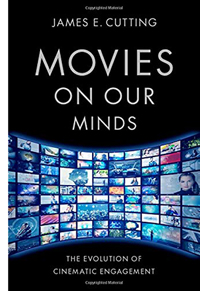 Over the decades, many psychologists have considered how the film medium has fitted itself to our perceptual and cognitive capacities. Julian Hochberg studied how the flow of shots creates expectations that guide our understanding of cinematic space. Under the influence of J. J. Gibson’s ecological theory of perception, Joseph Anderson reviewed the research that supported the idea that films feed on both strengths and shortcomings of the sensory systems we’ve evolved to act in the environment. In more recent years, Jeff Zacks, Joe Magliano, and other visual researchers, have gone on to show how particular techniques exploit perceptual shortcuts (as in Dan Levin’s work on change blindness and continuity editing errors https://vimeo.com/81039224). Outside the psychologists’ community, writers on film aesthetics have fielded similar arguments. An influential example is Noël Carroll’s essay “The Power of Movies.”
Over the decades, many psychologists have considered how the film medium has fitted itself to our perceptual and cognitive capacities. Julian Hochberg studied how the flow of shots creates expectations that guide our understanding of cinematic space. Under the influence of J. J. Gibson’s ecological theory of perception, Joseph Anderson reviewed the research that supported the idea that films feed on both strengths and shortcomings of the sensory systems we’ve evolved to act in the environment. In more recent years, Jeff Zacks, Joe Magliano, and other visual researchers, have gone on to show how particular techniques exploit perceptual shortcuts (as in Dan Levin’s work on change blindness and continuity editing errors https://vimeo.com/81039224). Outside the psychologists’ community, writers on film aesthetics have fielded similar arguments. An influential example is Noël Carroll’s essay “The Power of Movies.”
James Cutting’s Movies on Our Minds: The Evolution of Cinematic Engagement, itself the fruit of many years of intensive studies, builds on these achievements while taking wholly original perspectives as well. Comprehensive and detailed, it is simply the most complete and challenging psychological account of film art yet offered. I can’t do justice to its range and nuance here. Consider what follows as an invitation to you to read this bold book.
Laws of large numbers
The Martian (2015). Publicity still.
Cutting’s initial question is “Why are popular movies so engaging?” He characterizes this engagement—a more gripping sort than we experience with encountering plays or novels—as involving four conditions: sustained attention, narrative understanding, emotional commitment, and “presence,” a sense that we are on the scene in the story’s realm. Different areas of psychology can offer descriptions and explanations of what’s going on in each of these dimensions of engagement.
His prototype of popular cinema is the Hollywood feature film—a reasonable choice, given its massive success around the world. The period he considers runs chiefly from 1920 to 2020. He has run experimental studies with viewers, but the bulk of his work consists of scrutinizing a large body of films. Depending on the question he’s posing, he employs samples of various sizes, the largest including up to 295 movies, the smallest about two dozen. Although he insists he’s not concerned with artistic value, most are films that achieved some recognition as worthwhile. He and his research team have coded the films in their sample according to the categories he’s constructed, and sometimes that process has entailed coding every frame of a movie.
Like most researchers in this tradition, Cutting picks out devices of style and narrative and seeks to show how each one works in relation to our mind. His list is far broader than that offered by most of his predecessors; he considers virtually every film technique noted by critics. (I think he pins down most of those we survey in Film Art.) In some cases he has refined standard categories, such as suggesting varieties of reaction shot.
Starting with properties of the image (tonality, lens adjustments, mise-en-scene, framing, and scale of projection), he moves to editing strategies, the soundtrack, and then to matters of narrative construction. For each one he marshals statistical evidence of the dominant usage we find in popular films. For example, contemporary films average about 1.3 people onscreen at all times, while in the 1940s and 1950s, that average was about 2.5. Across his entire sample, almost two-thirds of all shots show conversations—the backbone of cinematic narrative. (So much for critics who complain that modern movies are overbusy with physical action.) And people are central: 90% of all shots show the head of one or more character.
Some of these findings might appear to be simply confirming what we know intuitively. But Big Data reveal patterns that neither filmmakers nor audiences have acknowledged. Granted, we’ve all assumed that reaction shots are important in cueing the audience how to respond. Cutting argues that despite their comparative rarity (about 15% of a film’s total) they are central to our overall experience: they are “popular movies’ most important narrational device.” They invite the audience to engage with the character’s emotions, and they encourage us to predict what will happen next.
This last role emerges in what Cutting calls the “cryptic reaction shot,” in which the response is ambivalent. Such shots show a moment when a character doesn’t speak in a conversation (for example, Jim’s reactions in my Mission: Impossible sequence). Filmmakers seem to have learned that
these shots are an excellent way to hook the viewer into guessing what the character is thinking—what the character might have said and didn’t. They also serve as fodder for predicting what the character will do next (174-175).
Cryptic reactions gather special power at the scene’s end. Whereas films from the 1940s and 1950s ended their scenes with such shots about 20% of the time, today’s films tend to end conversations with them almost two-thirds of the time. Since reading Cutting’s book I’ve noticed how common this scene-ending reaction shot is in movies (TV shows too). It’s a storytelling tactic that nobody, as far as I know, had previously spotted.
Similarly, Cutting tests Kristin’s model of feature films’ prototypical four-part structure. He finds it mostly valid, both in terms of data clustering (movement, shot lengths, etc.) and viewers’ intuitions about segmentation. But who would have expected what he found about what screenwriters call the “darkest moment”? Using measures of luminance, he finds that “this point literally is, on average, the darkest part of a movie segment” (285).
Cutting has found resourceful ways to turn factors we might think of as purely qualitative into parameters that can be counted and compared. To gauge narrative complexity, he enumerates the number of flashbacks, the amount of embedding (stories within stories), and particularly the number of “narrational shifts” in films. Again, there is a change across history.
Movies jump around among locations, characters, and time frames considerably more often than they used to. . . . Scenes and subscenes have gotten shorter. In 1940, they averaged about a minute and a half in duration, but by 2010 they were only about 30 seconds long (271-272).
His illustrative example is the climax of The Martian, where in four minutes and 35 shifts, the narration cuts together seven locations, all with different characters. Something similar goes on in the motorcycle chase of Mission: Impossible II and the final seventy minutes of Inception.
These examples show that Cutting is going far beyond simply tagging regularities in an atomistic fashion. Throughout, he is proposing that these patterns perform functions. For the filmmakers, they are efforts to achieve immediate and particular story effects, highlighting this or that piece of information. Showing few people in a shot help us concentrate on the most important ones. Conversations are the most efficient way to present goals, conflicts, and character relationships. Editing among several lines of action at a climax builds suspense. He suggests that because viewer mood is correlated with luminance, the darkest moment is triggering stronger emotional commitment.
But Cutting sees broader functions at work underneath filmmakers’ local intentions. Movies’ preferred techniques, the most common items on the menu, smoothly fit our predispositions—our tendencies to look at certain things and not others, to respond empathically to human action, to fit plots together coherently. Filmmakers have intuitively converged on powerful ways to make mainstream movies fit humans’ “ecological niche.”
And those movies have, across a century, found ways to snuggle into that niche ever more firmly. As we have learned the skills of following movie stories, filmmakers have pressed us to go further, stretching our sensory capacities, demanding faster and subtler pickup of information. Cutting’s numbers lead us to a conception of film history, the “evolution of cinematic engagement” promised in his subtitle.
Film history without names
Suspense (Weber and Smalley, 1913).
Central to Cutting’s psychological tradition is the idea that engagement depends minimally on controlling and sustaining attention. The techniques itemized almost invariably function to guide the viewer to see (or hear) the most important information. Filmmakers discovered that you can intensify attention by cooperation among the cues. Given that humans, especially faces, carry high information in a scene, you can use lighting, centered position, frontal views, close framings, figure movement, and other features of a shot to reinforce the central role of the humans that propel the narrative. When the key information doesn’t involve faces or gestures, you can give objects the same starring role.
Movies on Our Minds is very thorough in showing through statistical evidence that all these techniques and more combine to facilitate our attention. As an effort of will you can focus your attention on a lampshade, but it won’t yield much. The line of least resistance is to go with what all the cues are driving you to. But the statistical evidence also points to changes across history. What’s going on here?
Most basically, speedup. Cutting asked undergraduate students to go through films twice, once for basic enjoyment and then frame by frame, recording the frame number at the beginning and ending of each shot. He found that by and large the students enjoyed the older films, but some complained that these older movies were slower than what they ordinarily watched.
This impression accords with both folk wisdom and film research. Most viewers today note that movies feel very fast-moving, compared with older films. There’s also a considerable body of research indicating that cutting rates have accelerated since at least the 1960s. More loosely, I think most people think that story information is given more swiftly in modern movies; our films feel less redundant than older ones. Exposition can be very clipped. Abrupt changes from scene to scene are accentuated by the absence of “lingering” punctuation by fade-outs or dissolves. Indeed, one scene is scarcely over before we hear dialogue or sound effects from the next one. Characters’ motives aren’t always spelled out in dialogue but are evoked by enigmatic images or evocative sound. The Bourne Identity attracted notice not just for its fragmentary editing but also for its blink-and-you’ll-miss-them “threats on the horizon”—virtually glimpses of what earlier films would have dwelled on more. From this angle, Everything Everywhere All at Once represents a kind of cinema that grandpa, and maybe dad, would find hard to follow. (Actually, I’m told that some audiences today have trouble too.)
In The Way Hollywood Tells It, I suggested some causal factors shaping speedup, including various effects of television. Cutting grants that these may be in play, but just as he looks for an underlying pattern of functional factors in his ecology of the spectator, he posits a broad process of cinematic evolution similar to that in biology.
Look at film history simply as succession of movies. From a welter of competing alternatives, some techniques are selected and prove robust. They are replicated, modified in relation to the changing milieu. Others fail. For instance, the split-screen telephone shot of early cinema, as in the above frame from Suspense, became “a failed mutation” when shot/ reverse-shot editing for phone calls became dominant. As the main line of descent has strengthened, variation has come down to “selected tweaks” like eyelights and Steadicam movement.
Within this framework, filmmakers and audiences participate in a give-and-take.Through trial and error, early filmmakers collectively found ways to make films mesh with our perceptual proclivities. As viewers became more skilled in following a movie’s lead, there was pressure on filmmakers to go further and make more demands. If attention could be maintained, then shots could be shorter, scenes could move faster, redundancy could be cut back, complexity could be increased.
Viewers responded positively, embracing the new challenges of quicker pickup. As viewers became more adept, filmmakers could push ahead boldly, toward films like Memento and Primer. The most successful films, often financially rewarding ones like The Martian and Inception, suggest that filmmakers have continued to fit their boundary-pushing impulses to popular abilities.
Which means that audiences have adapted to these demands. But this isn’t adaptation in the strong Darwinian sense. With respect to his students’ reactions, Cutting writes:
I think . . . that the eye of a 20-year-old in the 2010s was faster at picking up visual information than the eye of a 20-year-old in the 1940s. This is not biological evolution. This is cultural education, however incidental it might be.
This process of cultural education, he suggests can be understood using Michael Baxandall’s concept of the “period eye.” Baxandall studied Italian fifteenth-century painting and posited that an adult in that era saw (in some sense) differently than we do today. Granted, people have a common set of perceptual mechanisms, but cultural differences intervene. Baxandall traced some socially-grounded skills that spectators could apply to paintings. In parallel fashion, given the rapidity of cultural change in the twentieth century, young people now may have gained an informal visual education, a training of the modern eye in the conventions of media.
Cutting insists that he isn’t suggesting that our attention spans have recently decreased, as many maintain. Instead, the idea of a period eye centers on
the growth and improvement of visual strategies as shaped by culture. If this idea is correct, then contemporary undergraduates have reason to complain about movies from the 1940s and 1950s that I asked them to watch.
By this account, film teachers have to recognize that their students, for whom any film before 2000 is an old movie, are possessed of a constantly changing “period eye.”
Failed mutations, or revision and revival?
City of Sadness (Hou, 1989).
I do have some minor reservations, which I’ll introduce briefly.
First, I don’t think that Baxandall’s idea of a period eye is a good fit for the dynamic that Cutting has identified. Baxandall’s concern is with a narrow sector of the fifteenth-century public: “the cultivated beholder” whom “the painter catered for.”
One is talking not about all fifteenth-century people, but about those whose response to works of art was important to the artist—the patronizing class, one might say. In effect this means a rather small proportion of the population: mercantile and professional men, members of confraternities or as individuals, princes and their courtiers, the senior members of religious houses. The peasants and the urban poor play a very small part in the Renaissance culture that most interests us now.
Ordinary viewers could recognize Jesus and Mary, the Annunciation or the Crucifixion, but for Baxandall the “period eye” involved a specific skill set. This was derived from such domains as business, surveying, ready reckoning, and a widespread artistic concepts like “foreshortening” or “stylistic ease.” The study of geometry prepared the perceiver to appreciate the virtuosity of perspective or proportion, but the untutored viewer could only marvel at the naturalness of the illusion.
It seems to me that Cutting’s 20-year-olds are not prepared perceivers in Baxandall’s sense. True, they may be alert to faulty CGI or a lame joke, but the whole point of focusing on mass-entertainment movies is that they engage multitudes, not coteries. The techniques Cutting explores are immediately grasped by nearly everybody, and no esoteric skills are necessary to feel their impact. Baxandall’s viewer is able to appreciate a painter’s rendition of bulk because he’s used to estimating a barrel’s capacity, but all Cutting’s viewer needs to get everything is just to pay attention.
Because the skills of following modern movies are so widespread, I wonder if Cutting’s case better fits the explorations of Heinrich Wöfflin, who flirted with the idea that “seeing as such has its own history, and uncovering these ‘optical strata’ has to be considered the most elementary task of art history.” Throughout his late career Wöfflin struggled to make the “history of vision” thesis intelligible. At times he implied that everyone in a given era “saw” in a way different from people in other eras. At other times he proposed that of course everyone sees the same thing but “imagination” or “the spirit” of the period and place shape how we understand what we see. This is murky water, and you can sense my skepticism about it. I don’t see how we could give the “period eye” for cinema much oomph on this front, but I think we might salvage Cutting’s central point. See below.
Secondly, by concentrating on mass-market cinema, “the movies,” and suggesting they fit our evolved capacities, we can easily overlook the alternatives. Obvious examples are the earliest cinema, which did involve some precise perceptual appeals (centering, frontality, selective lighting, emphasis through foreground/background relations) but not all the ones associated with editing. Given that tableau cinema had a longish ride (1895-1920 or so), it’s not inconceivable that, had circumstances been different, we would still have a cinema of distant framings and static long takes.
Cutting is aware of this. Rewind the tape of history, he says, and eliminate factors like World War I, and things could have turned out differently. But where would a long-running tableau cinema leave the story of cinema’s dynamic of natural selection? Would we have simply a steady state, without the acceleration of the last sixty years? Or would we look within the long history of tableau cinema for mutations and failed adaptations?
We have contemporary examples, in what has come to be called “slow cinema.” Hou Hsiao-hsien, Theo Angelopoulos, and other modern filmmakers have exploited the static long take for particular aesthetic effects. In another universe, they are the “movies” that hordes flock to see. Tableau cinema seems to me not a failed mutation, replaced by a style that more tightly meshed with spectators’ proclivities; it was an aesthetic resource that could be revived for new purposes. On a smaller scale, something like this happened with split-screen phone calls (as in Down with Love and The Shallows).
As the other arts show us, the past is available for re-use in fresh ways. Maybe nothing really goes away.
Which brings me to my last point. Baxandall’s emphasis on skills reminds us that we can acquire a new “eye” for appreciating films outside the mainstream. Cutting’s 20-somethings can learn to appreciate and even enjoy films that might strike them as slow. We call this the education of taste.
My inclination is to see the contemporary embrace of speedup as based in filmmakers’ and viewers’ more or less unthinking choices about taste. Indeed, Baxandall suggests that the period eye is a matter of “cognitive style,” a set of skills one person may have and another may lack.
There is a distinction to be made between the general run of visual skills and a preferred class of skills specially relevant to the perception of works of art. The skills we are most aware of are not the ones we have absorbed like everyone else in infancy, but those we have learned formally, with conscious effort: those which we have been taught.
Once the skills have been taught, we can exercise them for pleasure.
If a painting gives us opportunity for exercising a valued skill and rewards our virtuosity with a sense of worthwhile insight about that painting’s organization, we tend to enjoy it: it is to our taste.
I’d suggest that we have “overlearned” the skills solicited by mainstream movies and made them the automatic default for our taste. But we can also learn the skills for appreciating 1910s tableau cinema or City of Sadness. As we do so, we find we have cultivated a new dimension of our tastes. From this standpoint, the sensitive appreciators of slow cinema are far more like Baxandall’s educated Renaissance beholders than are the Hollywood mass audience. Perhaps to enjoy Feuillade or Hou today is to possess a genuine “period eye.”
None of this undercuts Cutting’s findings. But given the variety of options available, I’d argue that what the history of cinema reveals, among many other things, is a history of styles—some of which are facile to pick up, for reasons Cutting and his tradition indicate, and others which require effort and training and an open mind. Not clear-cut evolution, then, but just the blooming plurality we find in all the arts, with some styles becoming dominant and normative and others becoming rarefied . . . until artists start to make them mainstream. And the whole ensemble can be mixed and remixed in unpredictable ways.
There’s far too much in Movies on Our Minds to summarize here. It’s a feast of ideas and information, presented in lively prose. (The studies that the book rests upon are far more dependent upon statistics and graphs.) I should disclose that I read the book in manuscript and wrote a blurb for it. Consider this entry, then, as born of a strong admiration for James’s project.
Cutting’s book rests on years of intensive studies. Go to his website for a complete list. Most recently, he has traced a rich array of phone-call regularities across a hundred years. He has been a recurring player on this blog, notably here and here. James and I spent a lively week watching 1910s films at the Library of Congress, with results recorded here and here. The last link also provides more examples of revived “defunct” devices.
The tradition of film-psychological research I rehearse includes Hugo Münsterberg, The Film: A Psychological Study in Hugo Munsterberg on Film: The Photoplay: A Psychological Study and Other Writings, ed. Allan Langdale (Routledge, 2001; orig. 1916); In the Mind’s Eye: Julian Hochberg on the Perception of Pictures, Films, and the World, ed. Mary A. Peterson, Barbara Gillam, H. A. Sedgwick (New York: Oxford, 2007); Joseph D. Anderson, The Reality of Illusion: An Ecological Approach to Cognitive Film Theory (Southern Illinois University Press, 1996); Jeffrey Zacks, Flicker: Your Brain on Movies (Oxford, 2014). Noël Carroll’s essay “The Power of Movies” is included in his collection Theorizing the Moving Image (Cambridge, 1996).
Michael Baxandall’s most celebrated work is Painting and Experience in Fifteenth-Century Italy (Oxford, 1972); citations come from pages 29-29. My mention of Wölfflin relies on Principles of Art History: The Problem of the Early Development of Style in Early Modern Art, trans. Jonathan Blower (Getty Research Institute, 2015). My citation comes from p. 93.
One reference point for Cutting’s work is a book Kristin and I wrote with Janet Staiger, The Classical Hollywood Cinema, discussed here. See also Kristin’s Storytelling in the New Hollywood, which elaborates the argument for the four-part model, and my books On the History of Film Style and The Way Hollywood Tells It, along with the web video “How Motion Pictures Became the Movies.”
Bye Bye Birdie (1963).


